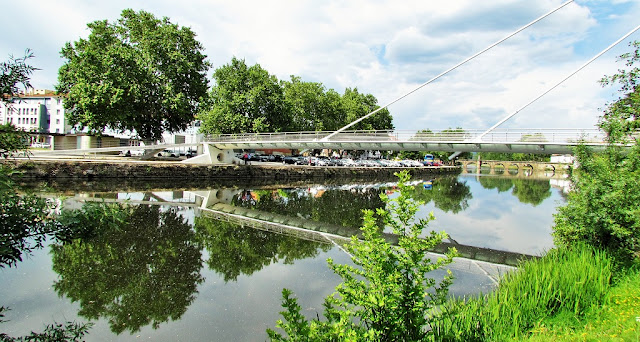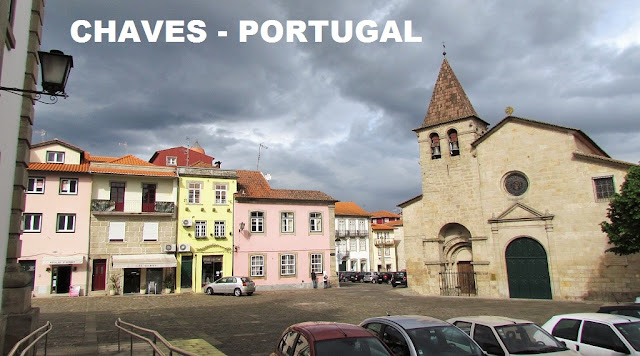CHAVES
N 41.73758; W 7.471456
Chaves is a city and a municipality in the north of Portugal. It is 10 km south of the Spanish border and 22 km south of Verín (Spain). The population in 2011 was 41,243, in an area of 591.23 km2. The municipality is the second most populous of the district of Vila Real (the district capital, Vila Real, is 60 km south on the A24 motorway). With origins in the Roman civitas Aquæ Flaviæ, Chaves has developed into a regional center. The urban area has 17,535 residents (2001).
Chaves is in the extreme north of Portugal, bounded on the north by Galicia (Spain), on the east by the municipalities of Vinhais and Valpaços, on the south by the municipality of Vila Pouca de Aguiar, and on the west by the municipalities of Montalegre and Boticas. Chaves is one of the six municipalities of the Alto Tâmega, situated in the district of Vila Real, strategically positioned in the northwest of the Iberian peninsula and accessed by important international highways.
Thermal springs
Mineral waters are the clearest evidence of these recent tectonic fractures. The Penacova-Régua-Verín Fault, is an active formation that extends longitudinally for 500 kilometres, intermingled with other faults resulting in subterranean hydrology. The thermal springs, principally those in Campilho and Salus Vidago (in Vila de Vidago) have developed from this mixture of circumstances. With temperatures reaching 73 °C (163 °F), these mineral springs (bicarbonates, sodium, silicates, and fluoride) in the vicinity of the city of Chaves, have provided a potential source of income.
The hot springs (Portuguese: Caldas) were known since the Roman period, when the town was Aquae Flaviae; the Waters of Flavius were an important social gathering point, but fell into disuse as the town was slowly abandoned by attacks. The spas belong to a vast area of hydrothermal springs that stretch from Verín (in Galicia) to Pedras Salgadas, 30 km from Chaves (on the road to Vila Real). Despite its vastness and abundance of water, this thermal system is little utilized; of the nine groups of thermal springs, there are only adequate installations in four of them: Chaves, Carvalhelhos, Vidago, Pedras Salgadas, and Verín. The waters of the spring, which are captured in three springs within Chaves, have mean temperatures of 73 °C (163 °F) (the hottest bicarbonate waters in Europe). The modern spa industry in Chaves uses these waters for numerous treatments, including stomach, liver, intestinal, and kidney ailments, through oral ingestion. Many small guesthouses in the old part of the town are dependent on the influx of these visitors. The thermal spas are located between the castle and the river, in front of a large area of the grass-covered park with playgrounds and tennis courts.
Climate
Chaves has a Mediterranean climate (Köppen: Csa) with continental and oceanic influences.
The mountains between the Minho region and Trás-os-Montes serve as a climatic barrier and lessen rainfall closer to the interior. Winters can be cold; January highs rarely surpass 12 °C (54 °F) and lows are often below zero. Fog often hovers over the valley during the winter, usually lifting by midday, but on rare occasions can last for days. Cold fronts from the Arctic can often cause daytime temperatures to drop below 5 °C. Snow is infrequent, especially in recent years although the surrounding hills often receive a dusting. Temperatures in July and August frequently pass 30 °C with nighttime temperatures dropping to 13 °C. Summer brush fires can often make this season unpleasant although in recent years they have diminished, perhaps because most of the forest cover has been burnt.
Economy
Agriculture and services are still the main sources of income. The traditional prosperity of Chaves comes, mainly, from a highly fertile plain, nine kilometres long and three to five wide, referred to as the"veiga". Since the land can be irrigated with canals there is intensive farming of potatoes, corn, rye, hay, while plots of vegetables are also commonplace in the local market. The main canal begins near Vila Verde da Raia and crosses the valley on the right bank of the Tâmega as far as Nantes. On the whole, the land is made up of small plots that are rarely economically viable. There is some dairy farming, and a milk production unit on the south side of town, but few cows can be seen in the valley. In general most of the farmers are of retirement age and farming is often pursued more as a hobby than as a profession.
In addition to agriculture, there are some small industries producing glass, tiles, and food products. Like Vila Pouca de Aguiar, located thirty kilometres south, this is a land of granite; there are several granite extraction and finishing industries located in Chaves, in addition to three brickworks, located on the south side of the city. Further, two mineral water plants, located in Vidago, belong to the municipality.
Transportation
It is serviced by A24 motorway, which links Chaves with the south, to Viseu, Coimbra and Figueira da Foz, connecting to Vila Pouca de Aguiar by the A7 (which acts as the gateway to the southern Trás-os-Montes), and the N103 from Bragança to Braga. Chaves is located 415 kilometres from Lisbon, 105 kilometres from Porto and just 55 kilometres from the district capital, Vila Real.
Chaves Airport, a small, single runway airport for light aircraft, also serves the town.
💓💓💓💓💓
SEARCH IN ALPHABETICAL ORDER IN
THE DISTRICT OF VILA REAL.
💓💓💓💓💓
Return to mainland Portugal &
the Azores and Madeira islands












































































































